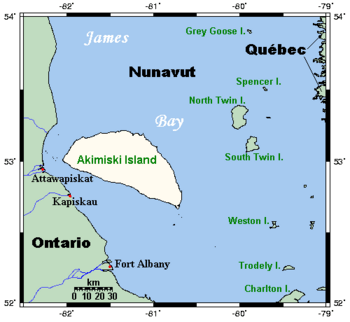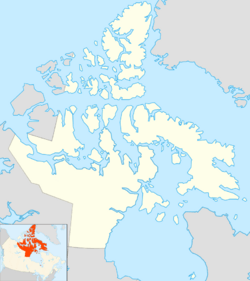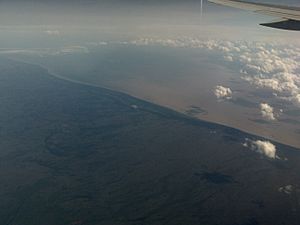Akimiski Island facts for kids

Closeup of Akimiski Island
|
|
| Geography | |
|---|---|
| Location | Nunavut |
| Coordinates | 53°00′30″N 081°16′30″W / 53.00833°N 81.27500°W |
| Archipelago | Arctic Archipelago |
| Area | 3,001 km2 (1,159 sq mi) |
| Highest elevation | 34 m (112 ft) |
| Administration | |
|
Canada
|
|
| Territory | Nunavut |
| Region | Qikiqtaaluk |
| Demographics | |
| Population | Uninhabited |
Akimiski Island is the largest island in James Bay (a southeasterly extension of Hudson Bay), Canada, which is part of the Qikiqtaaluk Region of the territory of Nunavut. It has an area of 3,001 km2 (1,159 sq mi), making it the 163rd largest island in the world, and Canada's 29th largest island. Akimiski Island is 19 km (12 mi) from the province of Ontario. From the western side of the island, the Ontario coastline is visible.
The island's name is Swampy Cree for "land across the water".
The island has no year-round human inhabitants; however, it is part of the Attawapiskat First Nation's traditional territory and is frequently used for traditional purposes. The surface of Akimiski is flat and slopes gradually to the north. Most of the vegetation that covers the island consists of lichen, moss, sedges, and dwarf black spruce. The island is a coastal wetland that includes mudflats, tidal marshes, and tidal mudflats. Freshwater streams that flow into southwestern James Bay carry sediments and abundant nutrients that help to sustain the productive waterfowl habitat around Akimiski Island.
The Akimiski Island Group includes Akimiski, Gasket, and Gullery islands; Albert Shoal; and the Akimiski Strait Isles.
Contents
Climate
- Mean annual temperature: 2.5 °C (36.5 °F)
- Average rainfall: 450 mm (17.72 in)
- Average snowfall: 25 cm (9.84 in)
Conservation
Akimiski Island is the site of the Akimiski Island Migratory Bird Sanctuary, a Canadian Important Bird Area, site #NU036 (53°10′12″N 081°19′48″W / 53.17000°N 81.33000°W). Its eastern portion is also a federal Migratory Bird Sanctuary, and much of the coastline is a Key Migratory Bird Terrestrial Habitat site.
Fauna
The coastal waters and wetlands of Akimiski Island (and James Bay in general) are important feeding grounds for many varieties of migratory birds. Notable species include:
Because James Bay and Hudson Bay are funnel-shaped, migrating birds from the Arctic concentrate in this area. During fall migration, an abundance of birds with both adults and young are present. In the springtime, the birds tend to reside in the southern areas of James Bay until the northern section thaws.
Among mammals, ringed seals, polar bears, and beluga whales can be found in the area.
See also
 In Spanish: Isla Akimiski para niños
In Spanish: Isla Akimiski para niños





